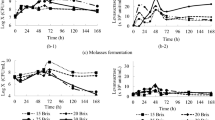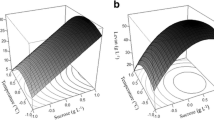Abstract
Fructooligosaccharides (FOS) and levan attract much attention due to a wide range of applications in food technology and pharmaceutical and cosmetic industry. Bacillus licheniformis ANT 179, isolated from Antarctica soil, produced levansucrase and levan in a medium containing sucrose as carbon substrate. In this study, characterization of levansucrase and production of short-chain FOS and levan were investigated. Temperature and pH optimum of the enzyme were found to be 60 °C and pH 6.0, respectively. The optimization of fermentation conditions for levan production using sugarcane juice by response surface methodology (RSM) was carried out. Central composite rotatable design was used to study the main and the interactive effects of medium components: sugarcane juice and casein peptone concentration on levan production by the bacterium. The optimized medium with sugarcane juice at 20 % (v/v) and casein peptone at 2 % (w/v) was found to be optimal at an initial pH of 7.0 and incubation temperature of 35 °C for 48 h. Under these conditions, the maximum levan concentration was 50.25 g/L on wet weight basis and 16.35 g/L on dry weight basis. The produced inulin type FOS (kestose and neokestose) and levan were characterized by Fourier transform infrared spectroscopy (FT-IR) and nuclear magnetic resonance (NMR) analysis. The study revealed that the levansucrase could form FOS from sucrose. The locally available low-cost substrate such as sugarcane juice in the form of a renewable substrate is proposed to be suitable even for scale-up production of enzyme and FOS for industrial applications. The levan and FOS synthesized by the bacterium are suitable for food applications and biomedical uses as the bacterium has GRAS status and devoid of endotoxin as compared to other Gram-negative bacteria.











Similar content being viewed by others
References
Morianoa, P.S., Lucia, F. A, Ana, P., Jesus, J.B., Antonio, O.B., Francisco, J.P. (2015) Levan versus fructooligosaccharide synthesis using the levansucrase from Zymomonas mobilis: effect of reaction conditions. Journal of Molecular Catalysis B.
Delgado, G. T. C., Wirla, M. S. C. T., & Glaucia, M. P. (2010). Immunomodulatory effects of fructans. Food Research International, 43, 1231–1236.
Lorenzoni, A. S. G., Luiza, F. A., Manuela, P. K., Rafael, C. R., & Plinho, F. H. (2014). Fructooligosaccharides synthesis by highly stable immobilized β-fructofuranosidase from Aspergillus aculeatus. Carbohydrate Polymers, 103, 193–197.
Park, J. P., Tae-Kwang, O., & Jong-Won, Y. (2001). Purification and characterization of a novel transfructosylating enzyme from Bacillus macerans EG-6. Process Biochemistry, 37, 471–476.
Srikanth, R., Gudimalla, S., Chinta, H. S. S., Sundhar, R., Harish, B. S., Janaki, R. M., & Kiran, B. U. (2015). Antioxidant and anti-inflammatory levan produced from Acetobacter xylinum NCIM 2526 and its statistical optimization. Carbohydrate Polymers, 123, 8–16.
Song, E., Hyunjin, K., Sung, H., & Jaeho, C. (2002). Cloning and characterization of a levan biohydrolase from Microbacterium laevaniformans ATCC 15953. Gene, 291, 45–55.
Nagnath, R. J., Mahesh, V. B., Ashwini, V. T., & Uday, S. A. (2012). Microbial Levan from Pseudomonas fluorescens: characterization and medium optimization for enhanced production. Food Science and Biotechnology, 21(4), 1045–1053.
Finore, H., Di Donato, P., Mastascusa, V., Nicolaus, B., & Poli, A. (2014). Fermentation technologies for the optimization of marine microbial exopolysaccharides production. Marine Drugs, 12, 3005–3024.
Antony, R., Krishnana, K. P., Laluraj, C. M., Thambana, M., Dhakephalkar, P. K., Anupama, S. E., & Shivaji, S. (2012). Diversity and physiology of culturable bacteria associated with a coastal Antarctic ice core. Microbiological Research, 167(6), 372–380.
Ramana, K. V., Singh, L., & Nalini, S. (2000). Psychrotrophic hydrolytic bacteria from Antarctica and other low temperature habitats. Defence Science Journal, 2, 177–181.
Laemmli, U. K. (1970). Cleavage of structural proteins during the assembly of the head of bacteriophage T4. Nature, 227, 680–685.
Senthilkumar, V., & Gunasekaran, P. (2005). Influence of fermentation conditions on levan production by Zymomonas mobilis CT 2. Indian Journal of Biotechnology, 4, 491–496.
Mckenzie, J. D. (2004). Minitab student release 14 statistical software for education. Boston: Pearson Addison-Wesley.
Myers, R. H., & Montgomery, D. C. (2002). Response surface methodology: process and product optimization using designed experiments (2nd ed.). New York: Wiley.
Ammar, Y. B., Matsubara, T., Ito, K., Iizuka, M., Limpaseni, T., Pongsawasdi, P., & Minamiura, N. (2002). Characterization of a thermostable levansucrase from Bacillus sp. TH4-2 capable of producing high molecular weight levan at high temperature. Journal of Biotechnology, 99, 111–119.
Velázquez-Hernández, M. L., Baizabal-Aguirre, V. M., Bravo-Patiño, M. A., Cajero-Juárez, M. P., Chávez-Moctezuma, M. P., & Valdez-Alarcón, J. J. (2009). Microbial fructosyltransferases and the role of fructans. Journal of Applied Microbiology, 106(6), 1763–1778.
Dube, S., Alam, S. I., & Singh, L. (2001). Proteolytic anaerobic bacteria from lake 396 sediments of Antarctica. Enzyme Microbial Technology, 28, 114–121.
Lu, L., Feng, F., Renfei, Z., Lan, J., Chunjuan, H., Li, X., & Min, X. (2014). A recombinant levansucrase from Bacillus licheniformis 8-37-0-1 catalyzes versatile transfructosylation reactions. Process Biochemistry, 49(9), 1503–1510.
Abdel-Fattah, A. F., Mahmoud, D. A. R., & Esawy, M. A. T. (2005). Production of levansucrase from Bacillus subtilis NCR 33 A and enzyme synthesis of levan and fructo-oligosaccharides. Current Microbiology., 55, 402–407.
Ikram-ul, H. A., Sikander, M. A., & Qadeer, I. J. (2002). Citric acid fermentation by mutant strain of Aspergillus niger GCMC-7 using molasses based medium. Electronic Journal of Biotechnology, 5, 125–132.
Paramjit, S. P. (2008). Application of response surface methodology in the permeabilization of yeast cells for lactose hydrolysis. Journal of Biochemical Engineering., 39, 91–96.
de Oliveira, M. R., da Silva, R. S. S. F., Buzato, J. B., & Colabone, C. M. A. P. (2007). Study of levan production by Zymomonas mobilis using regional low-cost carbohydrate sources. Biochemical Engineering Journal, 37, 77–183.
Tambara, Y., Hormaza, J. V., Perez, C., Leon, A., Arrieta, J., & Hernandez, L. (1999). Structural analysis and optimized production of FOS by levan sucrose from Acetobacter diazotrophics SRT4. Biotechnology Letters, 32, 117–121.
Ramsay, A., Cooper, D. G., & Neufeld, R. J. (1989). Effects of oil reservoir conditions on the production of water-insoluble levan by Bacillus licheniformis. Geomicrobiology Journal, 7(3), 155–165.
Kekez, B. D., Gojgic-Cvijovic, G. D., Jakovljevic, D. M., Stefanovic, K. J. R., Markovic, M. D., Beskoski, V. P., & Vrvic, M. M. (2015). High levan production by Bacillus licheniformis NS032 using ammonium chloride as the sole nitrogen source. Applied Biochemistry and Biotechnology, 75(6), 3068–3083.
Grube, M., Bekers, M., Upite, D., & Kaminska, E. (2002). IR-spectroscopic studies of Zymomonas mobilis and levan precipitate. Vibrational Spectroscopy, 28, 277–285.
Bagheri, L., Madadlou, A., Yarmand, M., & Mousavi, M. E. (2013). Nanoencapsulation of date palm pit extract in whey protein particles generated via desolvation method. Food Research International, 51(2), 866–871.
Poli, A., Hande, K., Bahar, G., Giuseppina, T., Giuseppina, P., Toksoy Oner, E., & Barbara, N. (2009). High level synthesis of levan by a novel Halomonas species growing on defined media. Carbohydrate Polymers, 78, 651–657.
Calub, T. M., Waterhouse, A. L., & Chatterton, N. J. (1990). Proton and carbon chemical shift assignments for 1-kestose from two-dimensional NMR spectral measurements. Carbohydrate Research, 199, 11–17.
Liu, J., Waterhouse, A. L., & Chatterton, N. J. (1991). Proton and carbon chemical shift assignments for 6-kestose and neo kestose from two dimensional NMR measurements. Carbohydrate Research, 217, 43–49.
Fujita, K., Kuwahara, N., Tanimoto, T., Koizumi, K., Iizuka, M., Minamiura, N., Furuichi, K., & Kitahata, S. (1994). Chemical structures of heterooligosaccharides produced by Arthrobacter sp. K-1 β-fructofuranosidase. Bioscience Biotechnology and Biochemistry, 58, 239–243.
Barthomeuf, C., Grizard, D., & Teulade, J. C. (1997). Assay and structural determination of fructooligosaccharides synthesized by an enzymatic system from Penicillium rugulosum. Biotechnology Techniques, 11, 845–848.
Hayashi, S., Yoshiyama, T., Fuji, N., & Shinohara, S. (2000). Production of a novel syrup containing neofructooligosaccharides by the cells of Penicillium citrinum. Biotechnology Letters, 22, 1465–1469.
Mabel, M. J., Sangeetha, P. T., Kalpana, P. K., Srinivasan, K., & Prapullaa, S. G. (2008). Physicochemical characterization of fructooligosaccharides and evaluation of their suitability as a potential sweetener for diabetics. Carbohydrate Research, 343, 56–66.
Bock, K., & Pedersen, C. (1983). Carbon-13 nuclear magnetic resonance spectroscopy of monosaccharides. Advances in Carbohydrate Chemistry and Biochemistry, 41, 27–66.
Tomašić, J., Jennings, H. J., & Glaudemans, C. P. J. (1978). Evidence for a single type of linkage in a fructofuranan from Lolium perenne. Carbohydrate Research, 62, 127–133.
Shih, I., Yu, Y., Shieh, C., & Hsieh, C. (2005). Selective production and characterization of levan by Bacillus subtilis (Natto) Takahashi. Journal of Agricultural and Food Chemistry, 53, 8211–8215.
Esawy, M. A., Ahmed, E. F., Wafaa, A. H., Mansour, N. M., El-Senousy, W. M., & El-Safty, M. M. (2012). Antiviral levans from Bacillus spp. isolated from honey. In K. D. Nedra (Ed.), The complex world of polysaccharides, InTech .ISBN 978-953-51-0819-1, chapter 7
Acknowledgments
We thank the Chairperson, Sophisticated Instrument Facility, Indian Institute of Science, Bangalore, India for providing NMR facilities.
Author information
Authors and Affiliations
Corresponding author
Rights and permissions
About this article
Cite this article
Xavier, J.R., Ramana, K.V. Optimization of Levan Production by Cold-Active Bacillus licheniformis ANT 179 and Fructooligosaccharide Synthesis by Its Levansucrase. Appl Biochem Biotechnol 181, 986–1006 (2017). https://doi.org/10.1007/s12010-016-2264-8
Received:
Accepted:
Published:
Issue Date:
DOI: https://doi.org/10.1007/s12010-016-2264-8




